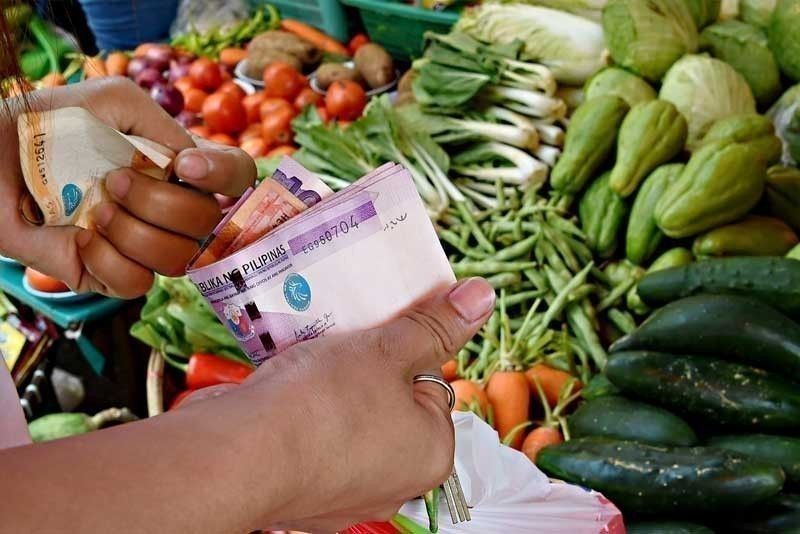Inflation spikes to 3.3% as food prices escalate

MANILA, Philippines — Growth in the prices of basic goods accelerated to a 21-month high of 3.3 percent in November after supply disruptions caused by recent typhoons pushed up food prices, the Philippine Statistics Authority (PSA) said.
In its latest report, the PSA said inflation – the rate of increase in the consumer price index – last month was driven mainly by rising food prices in the aftermath of the series of destructive typhoons that battered the country.
“Data show us that the growth in inflation comes from the food basket, particularly for vegetables, meat and fish,” said PSA head Dennis Mapa. “Because of the typhoons, there was a reduction in the supply of these commodities, thus pushing up prices.”
The Bangko Sentral ng Pilipinas (BSP) yesterday said the spike in inflation last month was only “transitory” as it expressed confidence full-year inflation would remain on target.
The headline inflation in November rose at a faster clip from 2.5 percent in October, bringing the 11-month average to 2.6 percent, placing it at the high end of the government’s revised inflation target of 2.4 to 2.6 percent for this year.
“Nonetheless, inflation is expected to settle within the government’s target range of three percent plus or minus one percent for 2020 to 2022 as the impact of supply disruptions due to recent typhoons is expected to be largely transitory,” BSP Governor Benjamin Diokno said.
Michael Ricafort, chief economist at Rizal Commercial Banking Corp. (RCBC), said the surge in inflation was only temporary, but said this could temper chances of further monetary policy easing.
“Though the latest spike in inflation is viewed as temporary or transitory, this could somewhat temper or limit any further monetary easing measures for now, especially and particularly on local policy rates, currently at the record low of two percent,” he said.
Diokno said the balance of risks to the inflation outlook is still tilted toward the downside due to potential disruptions to domestic and global economic activities amid the pandemic.
He said uncertainties remain following the resurgence of the coronavirus in the US, Europe and some parts of Asia.
“The reimposition of lockdowns could further dampen economic recovery,” he said.
While there is progress in the development of COVID-19 vaccines, Diokno said logistical issues in their distribution would have to be addressed before recovery could resume.
“The BSP stands ready to deploy its arsenal of instruments, as needed, in fulfillment of its mandate to maintain price and financial stability conducive to sustainable economic growth and employment,” he said.
Following its meeting last Thursday, the Development Budget Coordination Committee (DBCC) said it now expects inflation to settle at a range of 2.4 to 2.6 percent this year. The inflation assumption for 2021 and 2022 was retained at two to four percent.
The heavily weighted index of food and non-alcoholic beverages – which had a 51.7 percent share to headline inflation – registered a growth of 4.3 percent in November from 2.1 percent in October.
Significantly faster growth was seen in the prices of vegetables, meat, and fish, the supply of which was affected by the recent weather disturbances.
Reductions in the supply of pork because of the continued prevalence of African swine fever also pushed up pork prices.
Meanwhile, the index of alcoholic beverages and tobacco, grew by 12.3 percent in November from 11.3 percent in October.
Mapa said the uptick in the headline rate in November was still largely attributable to the supply disruptions caused by typhoons as there was still no indication among other commodity groups that early holiday spending for other goods was driving the uptick.
He said only the food and non-alcoholic beverages index and the alcoholic beverages and tobacco index registered growth while slowdowns were seen in the rest of the commodity groups while the index of recreation and culture continued to register negative growth.
Mapa said any improvement in the prices of vegetables in the coming days would indicate that the increase in prices was caused by supply issues that were transportation-related rather than production-related.
“We will track the prices of vegetables, meat, and fish. Usually for vegetables, prices may increase because of crop damage. But if these are just supply issues, we will see a deceleration of prices afterwards,” said Mapa.
- Latest
- Trending


























